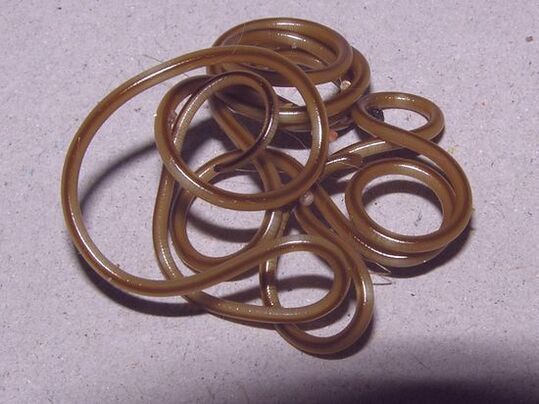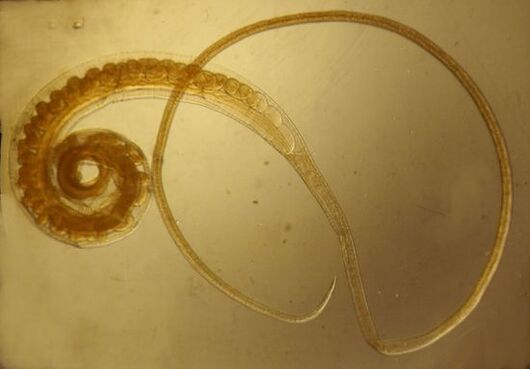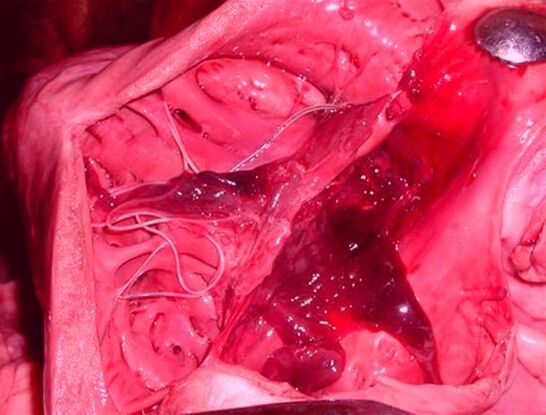
Healthy to live in the world - parasites in the body interfere with this. These are inferior forms of plants and animals, living at the expense of their owners. Translated from the Greek, it means - freeloader.
By way of parasites, they can be external and internal.
Parasites that live in the human body are divided into flat and round worms.
The flat is divided, in turn, into trematodes and cysts.
Ringworms are also called nematodes.
Nematodes that live in the human body

What parasites live in the body, first of all nematodes - they reach a length and have the form of earthworms, hence their name - ringworms, these are:
- roundworms;
- cream worms;
- hook worms;
- trichinella.
Round worms
One of the most common nematodes is a parasite, in some cases reaching a size of 45 cm. Females produce 200, 000 eggs, and this process occurs regardless of the presence of males in the host body. Along with the feces, the eggs fall to the ground, where, when good factors arise, they turn into larvae. You can be infected with this worm through dirty hands and unwashed vegetables, fruits, berries.
Signs of infection: nausea, salivation, loss of appetite. If there is a large number of ascaris, serious consequences may occur, rupture of postoperative sutures, the occurrence of pancreatitis. Ringworm is very dangerous for pregnant women - its penetration into the fetus is possible.
Cream worms
Small worms, measuring up to 10 mm, are infected mainly by children, more often in kindergartens. Sick people become the cause of infection, and if the rules of personal hygiene are not followed, the chances of infection increase significantly. Signs of worm appearance:
- night itching in the anal area;
- decreased performance;
- sleep disorders;
- nerve disorders.
The presence of cream worms is not life -threatening to the patient, but is quite unpleasant and causes dysbiosis.
Worms Worms
The 20 mm parasite has a pink color, gives fewer manifestations, but the danger from it is great. The oral cavity has teeth and a plate with which he gnaws blood vessels. Larvae penetrate the body through the skin of barefoot walkers.
The main task of the larvae is to enter the human mouth, from which, when swallowing saliva, they descend into the intestine, where the adult worms are excreted. They consume human blood, resulting in anemia. The threat is posed by their waste products, which poison the body. Signs of the presence of helminths are: persistent bronchitis, dermatitis, nausea, abdominal pain, digestive disorders. The heart suffers from this parasite - myocarditis may appear.
Trichinella
Females of worms reach up to 4 mm, males smaller. They die in the external environment and can only survive inside the body. The cause of infection is uncooked animal meat. Through the bloodstream, the parasite spreads to all organs, takes root and can live safely for 20 years.

The most common signs of infection are:
- an increase in eosinophilic leukocyte blood tests;
- increase in temperature to 40 ° C;
- muscle pain;
- conjunctivitis and swelling of the face.
Trematode parasite
Helminths, which are small in size, have a flat body, in which there are 2 suction cups. A large number of them are hermaphrodites. An intermediate host is required for development.
Fluke
Helminth - hermaphrodite, growing up to 14 mm, affects the bile ducts. The eggs, after entering a body of water, settle on mollusks, where they develop into larvae, then the larvae settle on fish scales. If at this time a person eats poorly fried fish, then he can be infected with this parasite.
In the body of its last host, a human, it happens to be inserted into the duodenum, where the larvae grow into adult worms. Water bodies are infected by chance by people who eat fish products and work on water vessels (the waste products penetrate into the water).
Schistosome
Helminths, having heterosexual individuals, resemble needles in appearance. One pair of parasites produces up to 3000 eggs in 24 hours. A person becomes infected while bathing or with contaminated water. In the lungs and blood vessels, the larvae become adults. After this, spawning takes place in the intestines.
In the presence of schistosomes, the following are observed:
- stomachache;
- violation of appetite;
- anemia;
- changing from diarrhea to constipation;
- weight reduction;
- cycle violations in women;
- impotence in men;
- declining school performance in children.
When introduced into nerve fibers, the development of paralysis, brain damage is possible.
Where helminths can be settled
Often people are interested in where parasites live in the human body?
The localization is due to the type of host that has entered the "parasitic" body. More often they settle in the digestive organs, in the lungs, heart, liver.
The human body, where the parasites live, becomes weak and begins to suffer from various diseases, so how to determine that the parasites live in the body is not at all difficult. You just need to be more concerned about yourself and if there is the slightest suspicion, you should not delay a visit to the doctor.

In order for the body in which the 6 -letter parasite lives to heal and become healthy, it must adhere to the rules of hygiene, do not drink raw water and do not eat poorly cooked meat. Only then can the risk of infection be reduced.
It’s fun to live in this world and you don’t want to think about parasites in the human body, but you should. However, every second person on Earth is infected with worms. The organism in which the parasite lives is a field of miracles, which is about to happen. But believing in fate is much of a weakness.



























